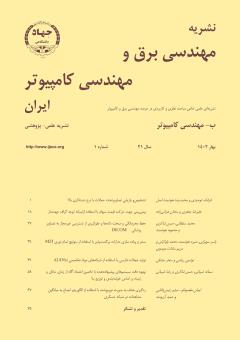ردگيری هدف به صورت توزيعشده با استفاده از الگوريتم اجماع به ميانگين مشاهدات در شبکه حسگری
محورهای موضوعی : مهندسی برق و کامپیوترايمان مقصودلو 1 , میثم رئیس دانائی 2 , حميد آرزومند 3
1 - دانشگاه جامع امام حسین (ع)
2 - دانشگاه جامع امام حسین (ع)
3 - دانشگاه جامع امام حسین (ع)
کلید واژه: ردگيری هدف, شبکه حسگری, فيلتر ذرهاي توزيعشده, مسئله اجماع به میانگین,
چکیده مقاله :
در اين مقاله، الگوریتم نوینی جهت کاهش شدید سربار مخابراتی در ردگيری توزيعشده (غیرمتمرکز) برای تکهدف در يک شبکه حسگری بیسیم ارائه گردیده است. این الگوریتم مبتني بر نگاه نوینی به حل مسئله اجماع به ميانگين و استفاده از فيلترهای ذرهای بهصورت توزيعشده است. در الگوريتم ارائهشده در این مقاله، بر عکس الگوریتمهای متداول که برای ردگیری توزيعشده جهت محاسبه وزن ذرات در فيلترهای ذرهای به حل مسئله اجماع به ميانگين برای تقریب تابع شبیهنمایی سراسری میپردازند، مدل جديدی براي مشاهده بر مبنای تقریب گوسی ارائه میشود که تنها در حل مسئله اجماع به ميانگين بر روی مشاهدات دریافتی گرهها در شبکه (و نه برای تقریب توابع شبیهنمایی سراسری) به کار گرفته میشود. این نوآوریها موجب کاهش قابل توجه ردوبدلشدن اطلاعات مابین گرههای شبکه و در نتیجه مصرف بسیار اندک منابع انرژی میگردد. در سناریوهای مختلف، کارايي الگوريتم پيشنهادی با الگوريتم متمرکز و الگوريتم توزيعشده مبتني بر گراف، مقايسه گردیده و نتايج شبيهسازی بیانگر آن هستند که با استفاده از این ایده، در ازای افت قابل قبول دقت ردگیری، سربار مخابراتی شبکه به شدت کاهش مییابد.
In this paper, a new algorithm is presented to drastically reduce communication overhead in distributed (decentralized) single target tracking in a wireless sensor network. This algorithm is based on a new approach to solving the average consensus problem and the use of distributed particle filters. For the algorithm of this paper, unlike the common algorithms that solve an average consensus problem just to approximate the global likelihood function to calculate the particle importance weights in distributed tracking, a new model for observation is presented based on the Gaussian approximation, which only solves the problem Consensus is applied to the mean on the received observations of the nodes in the network (and not to approximate the global likelihood function). These innovations significantly reduce the exchange of information between network nodes and as a result uses much less energy resources. In different scenarios, the efficiency of the proposed algorithm has been compared with the centralized algorithm and the distributed algorithm based on the graph, and the simulation results show that the communication overhead of the network is greatly reduced in exchange for an acceptable drop in tracking accuracy by using our proposed algorithm.
[1] Z. Ying and L. Gao, "Sensor-networked underwater target tracking based on grubbs criterion and improved particle filter algorithm," IEEE Access, vol. 7pp. 142894-142906, 2019.
[2] Z. Hao, Z. Xue, W. Zhuping, Y. Huaicheng, and S. Jian, "Adaptive consensus-based distributed target tracking, with dynamic cluster in sensor networks," IEEE Trans. on Cybernetics, vol. 5, no. 5, pp. 1580-1591, May 2018.
[3] R. Jesse, K. Achutegui, and J. Miguez, "A distributed particle filter for nonlinear tracking in wireless sensor networks," Signal Processing, vol. 98, pp. 121-134, May 2014.
[4] F. Zhao and L. Guibas, Wireless Sensor Networks: An Information Processing Approach, Morgan Kaufmann, San Francisco, CA, USA, 2004.
[5] W. Zhao and Y. Liang, "Energy-efficient and robust in-network inference in wireless sensor networks," IEEE Trans. on Cybernetics, vol. 45, no. 10, pp. 2105-2118, Oct. 2015.
[6] O. Hlinka, F. Hlawatsch, and P. Djuric, "Distributed particle filtering in agent networks: a survey, classification, and comparison," IEEE Signal Processing Magazine, vol. 30, no. 1, pp. 61-81, Jan. 2012.
[7] L. Xiao and S. Boyd, "Fast linear iterations for distributed averaging," Syst. Contr. Lett., vol. 53, no. 1, pp. 65-78, Sept. 2004.
[8] S. Farahmand, S. I. Roumeliotis, and G. B. Giannakis, "Set-membership constrained particle filter: distributed adaptation for sensor networks," IEEE Trans. Signal Processing, vol. 59, no. 9, pp. 4122-4138, Sept. 2011.
[9] D. Gu, J. Sun, Z. Hu, and H. Li, "Consensus based distributed particle filter in sensor networks," in Proc. Int. Conf. Inform. Automationpp. 302-307, Changsha, China, 20-23 Aug. 2008.
[10] Y. Xu, K. Xu, J. Wan, Z. Xiong, and Y. Li, "Maneuvering target tracking by using particle filter," in Proc. IEEE Joint 9th IFSA World Congress and 20th NAFIPS Int. Conf., pp. 2223-2228, Vancouver, Canada, 25-28 Jul. 2002.
[11] O. Hlinka, O. Sluciak, F. Hlawatsch, P. Djuric, and M. Rupp, "Likelihood consensus and its application to distributed particle filtering," IEEE Trans. on Signal Processing, vol. 60, no. 8, pp. 4334-4349, Aug. 2012.
[12] J. Y. Yu, M. J. Coates, and M. G. Rabbat, "Graph-based compression for distributed particle filters," IEEE Trans. on Signal and Information Processing over Networks, vol. 5, no. 3, pp. 404-417, Sept. 2019.
[13] A. Mohammadi and A. Asif, "Distributed consensus + innovation particle filtering for bearing/range, tracking with communication constraints," IEEE Trans. on Signal Processing, vol. 63, no. 3, pp. 620-635, Feb. 2014.


